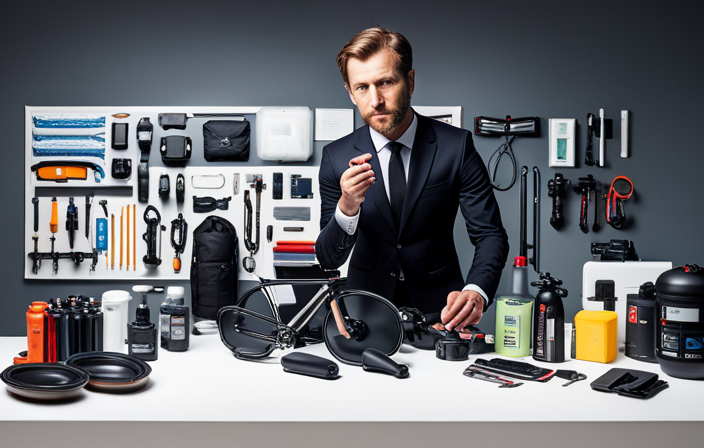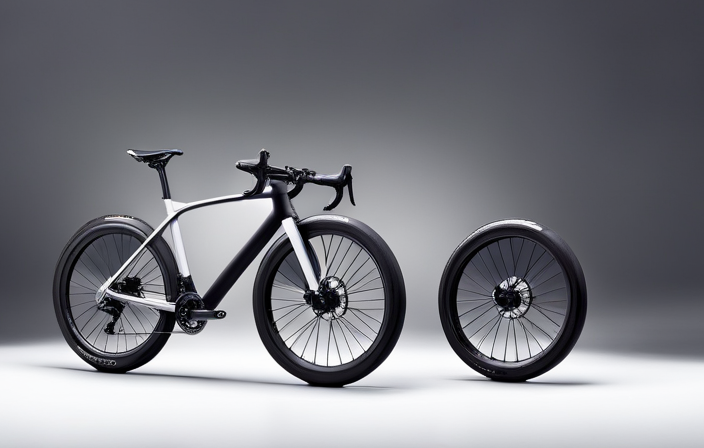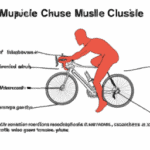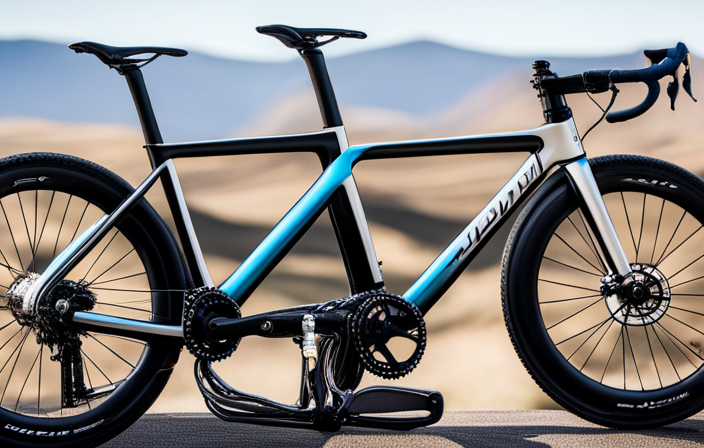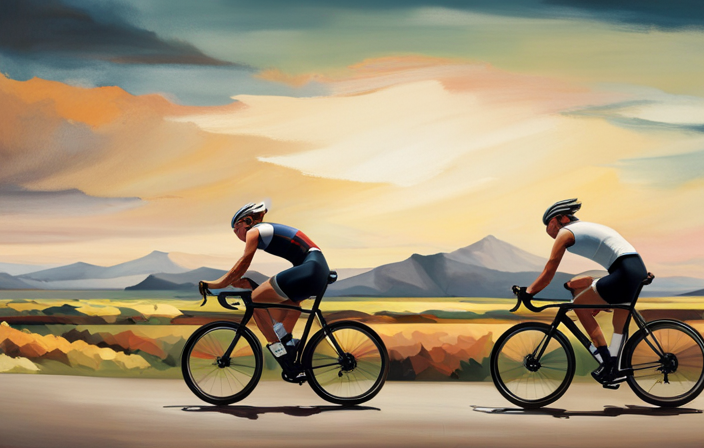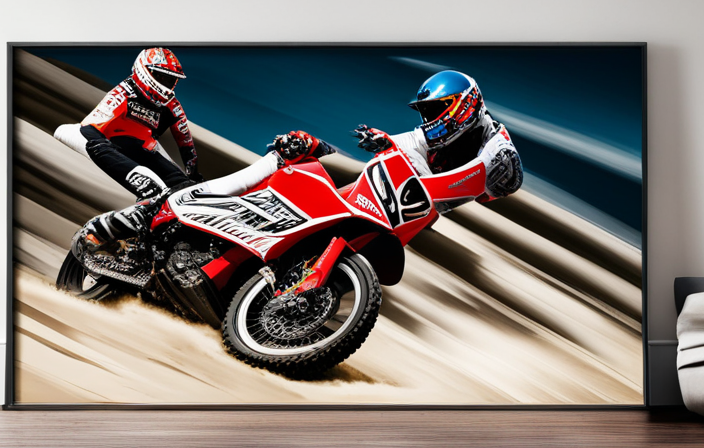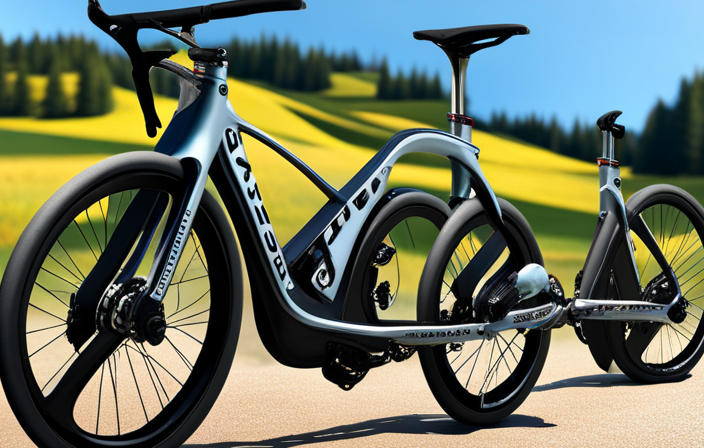In the cycling community, there are few challenges that rival a 100-mile gravel bike race. It tests strength, endurance, and mental toughness. Having completed this demanding distance, I recognize the significance of proper preparation.
In this article, I’ll share my insights and experiences on how to get ready for such an epic ride. From assessing your fitness level to incorporating cross-training and visualizing success, I’ll guide you through every step of the journey towards conquering that finish line.
Key Takeaways
- Assess your fitness level and set clear goals
- Gradually build endurance and incorporate interval training
- Strengthen your core and upper body
- Focus on proper nutrition, hydration, and mental preparation
Assess Your Fitness Level
You should assess your fitness level before starting your training for the 100-mile gravel bike race. Assessing progress and tracking improvements is crucial in order to set realistic goals and create an effective training plan.
When it comes to assessing your fitness level, there are a few key areas to focus on.
Firstly, evaluate your cardiovascular endurance. This is essential for long-distance cycling events like the 100-mile gravel race. Consider how far you can comfortably ride now, and gradually increase the distance over time to build up your endurance.
Next, analyze your muscular strength and endurance. Cycling requires strong leg muscles, so incorporate exercises like squats and lunges into your routine. Additionally, work on core strength as it helps with stability on the bike.
Furthermore, consider flexibility and mobility. Proper stretching before and after rides can prevent injuries and improve overall performance.
Lastly, take note of any previous injuries or limitations that may impact your training. Address these issues with appropriate modifications or seek professional advice if necessary.
Assessing your fitness level will give you a baseline to start from when creating a training plan tailored to your specific needs. With this knowledge in hand, you can set clear goals that align with improving your weaknesses while enhancing strengths.
Transitioning into the next section about ‘set clear goals and create a training plan,’ let’s discuss how setting targets will further guide our preparation for the 100-mile gravel bike race without delay!
Set Clear Goals and Create a Training Plan
Start by establishing clear objectives and crafting a training schedule to ensure success in the upcoming 100-mile gravel bike event. Setting specific goals will help you stay focused throughout your training journey. Determine what you want to achieve, whether it’s completing the race within a certain time or improving your overall performance. Once you have your objectives in mind, create a detailed training plan that includes specific workouts, rest days, and cross-training activities.
To make your training more enjoyable and relatable, consider these sub-lists:
- Mix up your training intensity: Incorporate different types of workouts into your schedule, such as interval sessions to improve speed and hill repeats to build strength.
- Monitor your progress: Track key metrics like distance covered, average speed, and heart rate during each training session. This will help you gauge improvement over time and adjust your training plan accordingly.
- Listen to your body: Pay attention to any signs of fatigue or injury. It’s important to push yourself during workouts but also know when to take rest days or modify exercises.
With clear goals in place and a well-crafted training plan, you’ll be on track for success in the 100-mile gravel bike race.
As we move into the next section about building endurance through long rides…
Build Endurance through Long Rides
Building endurance through long rides is essential for completing the 100-mile gravel bike event successfully. Endurance training is a crucial aspect of preparing for any endurance race, and long distance rides are a key component of this type of training. These rides help to build cardiovascular fitness, improve muscular endurance, and mentally prepare you for the demands of the race.
When incorporating long distance rides into your training plan, it’s important to gradually increase the duration and intensity of these rides over time. Start with shorter distances and gradually work your way up to longer rides, aiming to eventually ride close to or even beyond the 100-mile mark. This will not only help you physically adapt to riding longer distances but also allow you to test your equipment, nutrition strategies, and pacing.
During these long rides, focus on maintaining a steady pace that is sustainable throughout the distance. It can be helpful to break up the ride into smaller segments or set goals along the way as a way to stay motivated and focused.
Incorporate interval training for speed and power will be discussed in the next section. However, before diving into that topic, it’s important to establish a solid foundation of endurance through long distance rides.
Incorporate Interval Training for Speed and Power
Incorporating interval training enhances speed and power during your training for the 100-mile gravel bike event. Interval training benefits are numerous and can greatly improve your overall performance on race day. Here are four key reasons why you should consider adding intervals to your training regimen:
-
Boosts Speed: Interval training involves alternating between high-intensity bursts of effort and periods of active recovery. This type of training helps increase your anaerobic threshold, allowing you to maintain a faster pace for longer durations.
-
Improves Power Output: By pushing yourself to work at higher intensities during interval sessions, you can develop more explosive power in your pedal strokes. This increased power output will help you tackle challenging climbs or sprint ahead when needed.
-
Enhances Mental Toughness: Interval training pushes you out of your comfort zone and teaches you how to endure discomfort, both physically and mentally. This mental fortitude will be invaluable during the grueling 100-mile race.
-
Increases Stamina: Intervals can help enhance your cardiovascular endurance by improving oxygen utilization and increasing lung capacity. These adaptations will enable you to sustain a higher intensity for an extended period without fatiguing as quickly.
Incorporating interval training techniques into your routine is a game-changer that will undoubtedly benefit your performance in the 100-mile gravel bike race. However, it’s important to remember that there are other aspects of preparation that shouldn’t be neglected, such as strengthening your core and upper body…
Strengthen Your Core and Upper Body
To maximize your performance in the 100-mile gravel bike event, it’s crucial to focus on strengthening your core and upper body. Having a strong core and upper body not only improves your overall stability and balance on the bike but also enhances your endurance and power. Incorporating specific exercises that target these areas into your training routine will greatly benefit you on race day.
Upper body exercises such as push-ups, pull-ups, and shoulder presses are excellent for building strength in your arms, shoulders, and back. These exercises help you maintain proper posture while riding, especially when navigating rough terrain or climbing steep hills. Additionally, core strength training exercises like planks, Russian twists, and bicycle crunches improve your ability to generate power from the center of your body. This translates to more efficient pedaling and increased speed.
To evoke an emotional response in the audience, here is a table showcasing some effective upper body and core exercises:
| Upper Body Exercises | Core Strength Training |
|---|---|
| Push-ups | Planks |
| Pull-ups | Russian Twists |
| Shoulder Presses | Bicycle Crunches |
By incorporating these exercises into your training program consistently, you’ll notice significant improvements in both your upper body strength and core stability. With a stronger foundation, you’ll be better equipped to tackle the challenges of the 100-mile gravel bike race.
Now let’s transition into the next section about practicing bike handling skills without wasting any time.
Practice Bike Handling Skills
Improve your performance and control on the course by practicing your bike handling skills. Developing good bike handling skills is essential for any cyclist, especially when it comes to tackling a challenging 100-mile gravel race. Not only will it help you navigate through rough terrains and technical sections more efficiently, but it will also enhance your overall riding experience.
To improve bike handling, there are several key areas you should focus on:
-
Cornering technique: Practice taking corners at different speeds and angles. Lean into the turn while keeping your outside leg straight and applying pressure on the inside handlebar.
-
Braking control: Learn to modulate your brakes smoothly to maintain balance and traction. Practice emergency stops to develop quick reflexes.
-
Riding in a group: Join group rides or find cycling clubs in your area to gain experience riding close together with other cyclists. This will help you learn how to draft effectively and navigate tight spaces.
Developing these skills takes time, so be patient with yourself and practice regularly. Remember, consistency is key!
As you work on improving your bike handling, don’t forget about investing in the right gear and equipment. This will further enhance your performance and ensure that you have everything you need for the race ahead.
Invest in the Right Gear and Equipment
Make sure you invest in the proper gear and equipment to enhance your performance and make your riding experience more enjoyable. When preparing for a 100-mile gravel bike race, gear maintenance should be a priority. Regularly clean and lubricate your bike chain, check tire pressure, and inspect all components for wear or damage. This will ensure that your bike is in optimal condition on race day.
Additionally, wearing the right clothing is essential for comfort and protection during such a long ride. Choose moisture-wicking fabrics that will keep you dry and prevent chafing. A well-fitted helmet is crucial for safety, so make sure it meets industry standards and fits securely on your head.
To evoke an emotional response in the audience, I have created a table showcasing three must-have pieces of gear:
| Gear | Purpose | Emotional Benefit |
|---|---|---|
| Cycling shoes | Efficient power transfer | Confident pedaling |
| Padded shorts | Enhanced comfort | Pain-free riding |
| Lightweight jacket | Weather protection | Worry-free cycling |
Gear maintenance and proper clothing are key aspects of preparation for a 100-mile gravel race. By investing in high-quality gear and taking care of it properly, you can focus on training without worrying about equipment failures or discomfort. Now let’s discuss how to fine-tune your bike fit to further optimize your performance.
Fine-tune Your Bike Fit
Adjusting your bike fit can greatly enhance your riding experience and overall performance. When preparing for a 100-mile gravel bike race, it’s crucial to optimize your bike fit to ensure comfort and efficiency on the saddle. Here are some key steps to fine-tune your bike fit:
-
Seek professional help: Consider getting a professional bike fitting done by an experienced specialist. They will analyze your body measurements, flexibility, and riding style to make precise adjustments.
-
Saddle height adjustment: The correct saddle height ensures proper leg extension, preventing strain on the knees and maximizing power transfer. A professional fitter can help you find the optimal height for your unique physiology.
-
Handlebar position: Proper handlebar positioning reduces strain on your upper body and improves control over the bike. Adjusting the reach, drop, and width of the handlebars can enhance comfort during long rides.
-
Cleat alignment: Correct cleat alignment helps avoid knee injuries by promoting natural foot movement throughout the pedal stroke. Small adjustments to cleat position can have a significant impact on power transfer and pedaling efficiency.
By optimizing your bike fit through professional assistance, you’ll be able to ride with greater comfort and reduce the risk of injuries during training or racing.
Transitioning into the next section about fueling your body with proper nutrition is essential for maintaining energy levels throughout this demanding race without compromising performance or endurance.
Fuel Your Body with Proper Nutrition
To enhance your performance and maintain energy levels during the demanding 100-mile gravel bike race, it’s crucial to fuel your body with proper nutrition. Proper hydration and pre-race fueling are two key aspects of ensuring that you have enough energy to power through the race.
Firstly, let’s talk about proper hydration. Hydration is essential not only during the race but also in the days leading up to it. It’s important to drink plenty of fluids throughout the day, focusing on water and electrolyte-rich drinks. Dehydration can lead to fatigue, cramps, and decreased performance, so it’s crucial to stay hydrated.
Next, let’s discuss pre-race fueling. The days leading up to the race are just as important as race day itself when it comes to nutrition. Make sure you’re consuming a balanced diet that includes carbohydrates for energy, lean proteins for muscle repair, and healthy fats for sustained energy. Additionally, consider incorporating a carb-loading strategy in the days before the race to maximize glycogen stores in your muscles.
By properly hydrating and fueling your body before the 100-mile gravel bike race, you’ll give yourself the best chance of performing at your peak level.
Now let’s transition into how you can hydrate and stay hydrated during training and on race day without writing ‘step’.
Hydrate and Stay Hydrated during Training and the Race
Stay hydrated throughout your training and on race day to ensure optimal performance. One of the key aspects of hydration is maintaining electrolyte balance. Electrolytes are minerals that help regulate fluid balance in the body, and they play a crucial role in muscle function and overall performance.
During long rides and races, it is important to replenish these electrolytes through proper hydration.
To stay hydrated during long rides, start by drinking water regularly before you even feel thirsty. This will prevent dehydration and keep your body functioning properly. Additionally, consider incorporating electrolyte-rich sports drinks or supplements into your hydration routine. These can help replenish the electrolytes lost through sweat.
During the race itself, plan ahead by carrying enough water or sports drink with you to last for the duration of the event. It’s also a good idea to have a strategy for refueling at aid stations along the route. This may involve consuming both fluids and foods that contain electrolytes.
In conclusion, staying hydrated is essential for optimal performance in a 100-mile gravel bike race. Be sure to maintain electrolyte balance through proper hydration strategies such as regular water intake, incorporating electrolyte-rich drinks or supplements, and planning ahead for refueling during the race. By doing so, you’ll be setting yourself up for success on race day.
As we move onto discussing how to develop a recovery plan, it’s important to remember that post-race hydration plays an equally vital role in helping your body recover from intense physical exertion without explicitly stating "step."
Develop a Recovery Plan
After completing the 100-mile gravel bike race, it’s important for me to develop a recovery plan to help my body recover from the intense physical exertion. One of the key recovery strategies I employ is focusing on post-race nutrition.
It’s crucial to replenish depleted glycogen stores and repair muscle tissue after such a grueling event. I make sure to consume a balanced meal within 30 minutes of finishing the race, consisting of carbohydrates, protein, and healthy fats. This helps kickstart the recovery process and promote muscle repair.
In addition to proper nutrition, I also incorporate active recovery into my routine. This includes light cycling or low-impact exercises like swimming or yoga to increase blood flow and aid in muscle recovery. Foam rolling and stretching are also integral parts of my recovery plan as they help alleviate soreness and improve flexibility.
Furthermore, adequate rest is paramount for optimal recovery. Getting enough sleep allows my body to repair itself and recharge for future training sessions. I aim for at least 7-8 hours of quality sleep each night.
Transitioning into incorporating cross-training for overall fitness, it’s important to gradually introduce other activities such as strength training or running into your routine while allowing sufficient time for recovery between workouts.
Incorporate Cross-Training for Overall Fitness
When incorporating cross-training for overall fitness, I gradually introduced activities like strength training and running into my routine while allowing sufficient time for recovery between workouts. Cross-training has numerous benefits that can help improve your performance in a 100-mile gravel bike race.
It helps to prevent overuse injuries by working different muscle groups and reducing strain on specific areas of the body. Additionally, cross-training improves overall cardiovascular fitness, which is essential for endurance events like a long-distance bike race.
Incorporating different cross-training exercises into my routine was key to building overall fitness. Strength training exercises such as squats, lunges, and deadlifts helped to strengthen my leg muscles, improving power and stability on the bike. Running also played a crucial role in developing cardiovascular endurance and increasing leg strength.
Furthermore, cross-training allowed me to work on my mental toughness by pushing myself out of my comfort zone in different ways. It provided variety in my training regimen, preventing boredom and keeping me motivated throughout the preparation process.
As I continued with my cross-training program, it became important to familiarize myself with the race course. This involved studying maps, reading about other riders’ experiences, and even riding sections of the course beforehand to gain an understanding of its terrain and challenges.
Familiarize Yourself with the Race Course
As I mentioned earlier, cross-training is a crucial component of preparing for a 100-mile gravel bike race. By incorporating activities like running, swimming, or weightlifting into your training routine, you can improve your overall fitness and prevent overuse injuries. However, it’s not enough to just focus on physical conditioning; you also need to familiarize yourself with the race course.
Understanding the race course is essential for developing a solid race strategy and mental toughness. Here are three key reasons why:
-
Accurate pacing: Knowing the terrain and elevation changes will help you determine how fast or slow to ride at different sections of the course.
-
Proper gear selection: Being aware of any technical sections or challenging climbs will allow you to choose appropriate gear ratios and tire pressures in advance.
-
Mental preparation: Familiarizing yourself with the race course helps build mental toughness by visualizing success on difficult segments and knowing what to expect during the race.
By understanding the ins and outs of the race course, you’ll be better prepared both physically and mentally. This knowledge will lay a foundation for another important aspect of preparation – practicing mental preparation and visualization techniques – which we’ll explore in detail next.
Practice Mental Preparation and Visualization Techniques
To improve your performance and mental toughness, it’s important to incorporate mental preparation and visualization techniques into your training routine. When it comes to preparing for a 100-mile gravel bike race, the physical aspect is just one piece of the puzzle. Your mindset plays a crucial role in determining how well you perform on race day.
One effective technique is visualization. By mentally rehearsing the race, you can familiarize yourself with different scenarios and prepare for any challenges that may arise. Close your eyes and imagine every detail: the start line, the terrain, even the feeling of fatigue in your legs. Visualize yourself pushing through difficult moments and crossing the finish line strong and victorious. This practice helps build confidence and reduces anxiety.
Another important aspect of mental preparation is setting goals. It’s essential to have both short-term goals (such as reaching certain checkpoints within specific time frames) and long-term goals (like finishing in a certain place or achieving a personal record). Setting these targets gives you something to strive for during the race.
Incorporating visualization techniques and setting clear goals will help you develop mental fortitude during the 100-mile gravel bike race. With a strong mind, you’ll be better equipped to handle whatever challenges come your way on race day.
Now, onto getting plenty of rest and sleep before the race…
Get Plenty of Rest and Sleep before the Race
Make sure you get enough rest and sleep before the event to ensure your body is fully recovered and ready for the race. Rest and recovery are crucial components of any training plan, but they become even more important as you approach race day. Your body needs time to repair itself and recharge its energy stores in order to perform at its best.
Aim for a solid 8 hours of sleep each night leading up to the race, and try to establish a consistent bedtime routine to help signal your body that it’s time to wind down. In addition to quantity, sleep quality is also important. Create a comfortable sleeping environment by keeping your bedroom cool, dark, and quiet. Avoid stimulating activities or electronics before bed, as they can interfere with your ability to fall asleep. Consider using relaxation techniques such as deep breathing exercises or meditation to calm your mind before bedtime.
During the final week before the race, prioritize rest days in your training schedule. This allows your muscles time to recover from all of the hard work you’ve put in during training. Taking it easy will also help prevent any last-minute injuries or fatigue that could hinder your performance on race day.
Remember, getting enough rest and sleep is just as important as putting in the miles on the bike. So make it a priority in your preparation for the 100-mile gravel bike race!
Frequently Asked Questions
How do I mentally prepare for a 100-mile gravel bike race?
To mentally prepare for a 100-mile gravel bike race, I rely on visualization techniques and mental strength strategies. I envision myself conquering challenging sections of the course, feeling strong and determined. This helps me build confidence and reduce anxiety.
Additionally, I focus on positive self-talk, reminding myself of my training and past successes. Breathing exercises and meditation also help me stay calm during the race.
Mental preparation is key to staying focused and pushing through any obstacles that may arise.
What cross-training exercises should I incorporate for overall fitness?
For overall fitness, I recommend incorporating strength training and cardiovascular endurance exercises into your routine.
Strength training will help build muscle and increase your power on the bike. Focus on exercises like squats, lunges, and deadlifts to target your lower body.
For cardiovascular endurance, activities like running, swimming, or rowing can improve your stamina and lung capacity.
Aim for a combination of both types of exercise to ensure you are well-rounded in your fitness journey.
What are some visualization techniques that can help during the race?
Visualization techniques can be a game-changer during a race. Picture this: as I pedal through the challenging terrain, I close my eyes for a moment and visualize myself effortlessly conquering each obstacle. This mental focus helps me stay motivated and overcome any doubts or fatigue.
I imagine crossing the finish line with a triumphant smile on my face, fueling my determination to push harder. Visualization truly enhances my performance and keeps me in the zone throughout the race.
How can I fine-tune my bike fit for optimal performance?
To fine-tune my bike fit for optimal performance, I focus on three key areas: position, comfort, and efficiency.
First, I ensure that my saddle height and fore/aft position are dialed in to maximize power transfer and minimize strain.
Second, I pay attention to handlebar reach and drop to find a comfortable position that allows for control and aerodynamics.
Finally, I optimize pedal stroke by adjusting cleat position and alignment for efficient power delivery.
These adjustments greatly enhance bike fit and ultimately improve performance on the bike.
What are some recovery strategies I should include in my plan?
Recovery strategies are crucial for a successful race. After crossing the finish line, I prioritize replenishing my body with post-race nutrition rich in carbohydrates and protein to repair muscle tissue.
Additionally, I engage in active recovery exercises like light cycling or stretching to promote blood flow and reduce muscle soreness.
Adequate rest is also vital, allowing my body time to heal and recover.
These strategies have helped me bounce back quickly and continue training effectively.
Conclusion
In conclusion, preparing for a 100-mile gravel bike race requires dedication, discipline, and a well-rounded training plan. By assessing your fitness level, setting clear goals, and incorporating various training techniques such as long rides, interval training, and cross-training, you can build the endurance and strength necessary to conquer the race course.
Don’t forget to also focus on mental preparation and visualization techniques to stay focused during the race. Remember, success in this challenging event is not just about physical fitness but also about mental resilience.
So rest up, trust your training, and enjoy the journey towards achieving your goals on race day!
